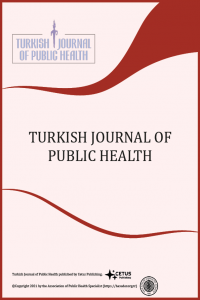Türkiye’deki yol güvenliği kararlarının Haddon Matrisi ve 7Es ile incelenmesi
karayolu güvenliği kararları, politika analizi, Haddon Matrisi, politika geliştirme, halk sağlığı
The investigation of Turkey’s road safety decisions by Haddon Matrix and 7Es
___
- Larsson P, Dekker SW, Tingvall C. The need for a systems theory approach to road safety. Saf Sci 2010;48(9):1167-1174.
- Özkan T, Lajunen T. A general traffic(safety) culture system (G-TraSaCu-S).TraSaCu project, European Commission,RISE Programme. 2015;1–47.
- Scott-Parker B, Goode N, Salmon P.The driver, the road, the rules . . . and the rest? A systems-based approach to young driver road safety. Accid Anal Prev 2015;74:297–305.
- Özkan T, Öztürk İ, Üzümcüoğlu Y, Bıçaksız P, Yıldırım E, Vursavaş F, Daşkın O, Turgut S, Sayı İE, Battal Ö, Söylemez M, Kurban S. Trafik Kurul Kararlarının Analizi – Türkiye Değerlendirmesi.Emniyet Genel Müdürlüğü. Available at: http://www.trafik.gov.tr/kurumlar/trafik.gov.tr/06-Yayinlar/Diger/TKKA_TurkiyeDegerlendirmesi.pdf. 2015.
- Albertsson P, Björnstig U, FalkmerT. The Haddon Matrix, a tool for investigating severe bus and coach crashes. International Journal of Disaster Medicine 2003;2:109–119.
- Runyan CW. Introduction: Back to the Future—Revisiting Haddon’s Conceptualization of Injury Epidemiology and Prevention. Epidemiol Rev 2003;25:60–64.
- Barnett DJ, Balicer RD, Blodgett D, Fews AL, Parker, CL, Links JM. The Application of the Haddon Matrix to Public Health Readiness and Response Planning. Environ Health Perspect 2005;113(5):561–566.
- Zhong S, Clark M, Hou XY, Zang YL, FitzGerald G. 2010–2011 Queensland floods: Using Haddon’s Matrix to define and categorise public safety strategies. Emerg Med Australas 2013;25:345–352.
- Rustagi N, Kumar A, Norbu L, Vyas D. Applying Haddon Matrix for Evaluation of Road Crash Victims in Delhi, India. Indian J Surg 2017;80(5):479–487.
- Haddon WJr. A logical framework for categorising highway safety phenomena and activity. J Trauma 1972;12(3):193–207.
- Baru A, Azazh A, Beza L. Injury severity levels and associated factors among road traffic collision victims referred to emergency departments of selected public hospitals in Addis Ababa, Ethiopia: The study based on the Haddon matrix.BMC Emerg Med. 2019;19(2):1–10.
- Yaacob NFF, Rusli N, Bohari SN. A review analysis of accident factor on road accident cases using Haddon Matrix approach. Proceedings of the Second International Conference on the Future of ASEAN (ICoFA) 2017;2.
- Haddon WJr. The changing approach to the epidemiology, prevention, and amelioration of trauma: The transition to approaches etiologically rather than descriptively based. Am J Public Health Nations Health 1968;58(8):1431–1438.
- Haddon WJr. Advances in the epidemiology of injuries as a basis for public policy. Public Health Rep 1980;95(5):411–421.
- Goniewicz K, Goniewicz M, Pawlowski W, Fiedor P. Road accident rates: strategies and programmes for improving road traffic safety. Eur J Trauma Emerg Surg 2015;42(4);433–438.
- Oster CVJr, Strong JS. Analyzing road safety in the United States. Research in Transportation Economics 2013;43:98–111.
- Üzümcüoğlu Y, Özkan T, Lajunen T, Morandi A, Orsi C, Papadakaki M, Chliaoutakis J. Life quality and rehabilitation after a road traffic crash:A literature review. Transp Res Part F Traffic Psychol Behav 2016;40:1–13.
- Short MM, Mushquash CJ, Bédard, M. Interventions for motor vehicle crashes among Indigenous communities: Strategies to inform Canadian initiatives. Can J Public Health 2014;105(4):296–305.
- Groeger JA. How many e’s in road safety.In B. E. Porter (Ed.), Handbook of Traffic Psychology (pp.3–12). San Diego, CA:Elsevier.
- Assailly JP. Road safety education:What works? Patient Educ Couns 2017;100S:S24–S29.
- Wang C, Quddus MA, Ison SG. The effect of traffic and road characteristics on road safety: A review and future research direction. Saf Sci 2013;57:264–275.
- Elvik R, Høye A, Vaa T, Sørensen, M. The handbook of road safety measures. 2nded. Bingley, UK: Emerald; 2009.
- Bui DP, Balland S, Giblin C, Jung AM, Kramer S, Peng A, Aquino MCP, Griffin S, French DD, Porter KP, Crothers S, Burgess JL. Interventions and controls to prevent emergency service vehicle incidents: A mixed methods review. Accid Anal Prev 2018;115:189–201.
- Scholtes B, Schröder-Bäck P, Mackay M, Vincenten J, Brand H. (2017). Child safety reference frameworks: A policy tool for child injury prevention at the subnational level. Cent Eur J Public Health 2017;25(2):120–128.
- Hughes BP, Anund A, Falkmer T. A comprehensive conceptual framework for road safety strategies. Accid Anal Prev 2016;90:13–28.
- Haddon WJr. Energy damage and the 10 countermeasure strategies. Inj Prev 1995;1:40–44.
- World Health Organization. Global status report on road safety. Available at:https://www.who.int/violence_injury_prevention/road_safety_status/2018/en/. 2018.
- Haddon WJr. On the escape of tigers: an ecologic note. Am J Public Health Nations Health, 1970;60(12):2229-2234.
- Siegrist S. Towards a method to forecast the effectiveness of national road safety programmes. Saf Sci 2010;48(9):1106–1110.
- Gupta S, Hoe C, Özkan T, Lajunen TJ, Vursavas F, Sener S, Hyder AA. Evaluation of a five-year Bloomberg Global Road Safety Program in Turkey. Public Health 2017;144:S45–S56.
- OECD. Evaluation Criteria. Available at: https://www.oecd.org/dac/evaluation/daccriteriaforevaluatingde
- Noy YI. Human factors in modern traffic systems. Ergonomics 1997;40(10):1016–1024.
- McIlroy RC, Plant KA, Hoque MS, Wu J, Kokwaro GO, Nam VH, Stanton NA. Who is responsible for global road safety? A cross-cultural comparison of Actor Maps. Accid Anal Prev 2019;122:8–18.
- Başlangıç: 2003
- Yayıncı: Halk Sağlığı Uzmanları Derneği
Zeynep DURMUŞOĞLU, Pınar KOCABEY ÇİFTÇİ
Kayseri ili 2018 yılı HPV tarama sonuçlarının değerlendirilmesi
Serkan YILDIZ, Mehmet Emin ÖZDEMİR, Mebrure Beyza GÖKÇEK, Nadir Emre ÜNSAL, Berkan ASLAN, Ali Ramazan BENLİ
Türkiye’deki yol güvenliği kararlarının Haddon Matrisi ve 7Es ile incelenmesi
İbrahim ÖZTÜRK, Pınar BIÇAKSIZ, Yeşim ÜZÜMCÜOĞLU ZİHNİ, Türker ÖZKAN
Nasar Ahmad SHAYAN, Erhan ESER, Ahmad NEYAZİ, Sultan ESER
Babita KURUVİLLA, Ann THOMAS, Jacob KALLİATH, Alexander JOHN, Brilly ROSE
Türkiye’de Göçmenlere Sunulan Sağlık Hizmetleri İçin Yürütülen İletişim Çalışmaları
Sevil TURHAN, Selen GÜRSOY, Serdar KARAKULLUKÇU
Afganistan’da sağlık çalışanlarında tükenmişlik sendromu sıklığı ve ilişkili risk faktörleri
Farklı kilo verme yöntemlerinin ve yöntemlere uyumun kilo verme ve kontrolü ile ilişkisi
Fatih GÜLTEKİN, Halil İbrahim BÜYÜKBAYRAM, Duygu KUMBUL DOĞUÇ, Hikmet ORHAN, Osman GÜRDAL, Mücahit EĞRİ, Rıza ÇITIL, Mustafa TÖZÜN, Ahmet Nesimi KİŞİOĞLU, Fatih KARA, İlter İLHAN, Muazzez GARİPAĞOĞLU
Halk sağlığı bakış açısıyla teletıp
Deren ÖZYÜREK UCAEL, Mustafa ÖZDEN, Ercüment ALTINTAŞ, Dilek ASLAN
COVID-19 pandemisi döneminde genç erişkinlerin psikolojik özelliklerinin araştırılması
